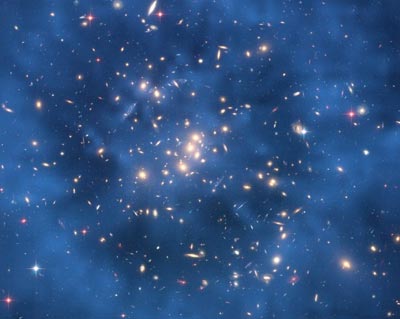
For over 70 years astrophysicists have speculated what might compose the missing dark matter that seems to make up over 80% of all mass in the universe. The typical candidates are fundamental entities known as weakly interacting massive particles, or WIMPs, but new research suggests something more peculiar would better fit the bill.
According to Kathryn Zurek of the University of Michigan and colleagues, “quirky composite dark matter” could explain the universe’s missing mass, but would be free of some of the usual problems associated with conventional WIMP dark matter. “People are becoming more and more open to more complex theories of dark matter,” says Zurek.
WIMPs are so called because they interact with normal “baryonic” matter only through gravity and the weak nuclear force. But after decades of searching, the WIMP hypothesis is starting to come under increasing scrutiny. First, direct-detection experiments – such as the XENON100 experiment at the Gran Sasso laboratory in Italy, or the CDMS experiment in the US – have not yet found any convincing evidence for the existence of WIMPs. This has led to the conclusion that WIMPs must interact exceptionally weakly with normal matter.
Perhaps more importantly, though, there seems to be no reason why dark matter is just four times more abundant than normal matter – in other words, why it has abundance on the same order of magnitude. Since astrophysicists are used to dealing with differences in orders of magnitude of 10, 20 or more, this feature looks like something of a coincidence.
A quirky solution
Quirky dark matter offers a way out of the interaction and coincidence problems. Hypothesized in 2008 by US physicists Junhai Kang and Markus Luty, “quirks” are similar to the quarks that make up in the nucleons inside atoms in that they bind together into composite particles. However, quirks would be much heavier, and rather than be bound by the nuclear strong force, they would be bound by a new type of force – a “dark” strong force. When two oppositely charged quirks bind together they would form, similar to a neutron, a neutral particle. In this latest research, Zurek and her team have developed this theory into a more comprehensive model of dark matter.
It is the innate charge of quirks that enables them to avoid the WIMP coincidence problem. Charge links the quirk abundance to the same processes in the Standard Model of particle physics that determine baryon abundance, so there should naturally be a roughly balanced ratio of quirks (dark matter) to baryons (normal matter). And the composite’s overall neutrality, both in charge and electroweak coupling, would explain why direct detection experiments have so far failed to dig up any evidence.
Neal Weiner, a cosmologist and particle physicist at New York University, says that Zurek has come upon an interesting model. “She and her collaborators have taken these [issues with conventional WIMP dark matter] and really made some headway with them,” he says. “But the best thing is that she has shown how these models can be relevant for experiments. This is not just a theoretical exercise – if any of these ideas are right, we may learn soon.”
Read between the lines
One of the ways experiments could detect quirky dark matter results from the exact nature of each quirk in the composite. If they are just slightly different – say, in mass – the quirks might rarely exchange a photon with an atom’s proton or neutron, and in this way create a nuclear recoil in one of the conventional direct-detection experiments. Moreover, the ability to absorb photons could mean that quirky dark matter has an array of absorption lines, rather like the “Lyman” lines for hydrogen. If the light from a distant source such as a quasar were to shine through a clump of quirky dark matter en route to Earth, telescopes should see these absorption lines in the light spectrum.
As Zurek herself points out, this sort of detection would rely on a bright enough light source and a dense enough clump of quirky dark matter. But with experiments failing so far to find any convincing evidence of conventional WIMP dark matter, physicists may find they have to start exploring more esoteric possibilities. “There could be dark forces, there might be multiple scales in the dark-matter sector, there could be this kind of structure where there’s these excited states…all of a sudden we’re starting to think in terms of much more complex dynamics,” says Zurek.
The research is available at arXiv: 0909.2034.



